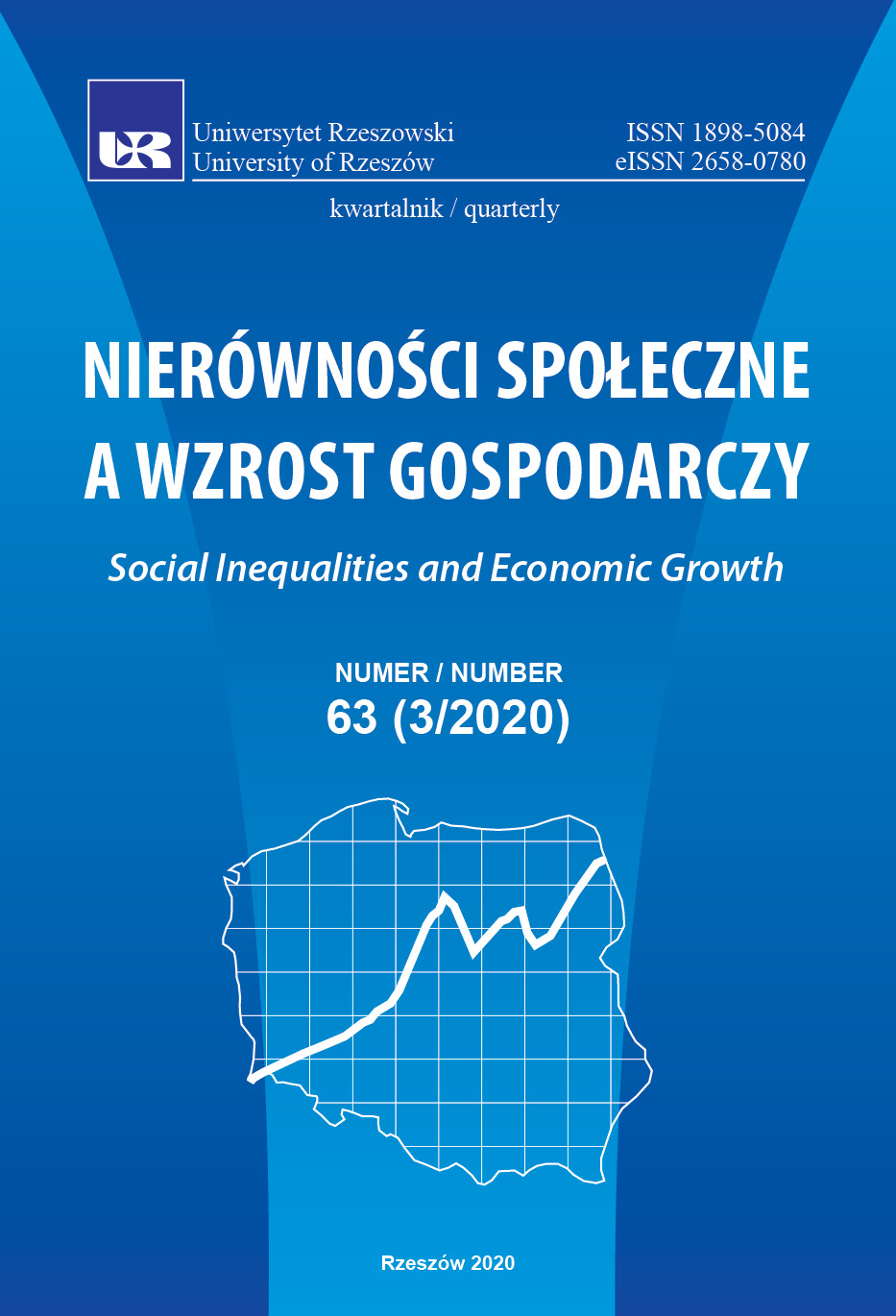Rozwój inkluzywny – Polska na tle innych krajów OECD
DOI:
https://doi.org/10.15584/nsawg.2020.3.17Słowa kluczowe:
inkluzywność, wzrost, rozwój, wykluczenie ekonomiczne i społeczne, OECDAbstrakt
Rozwój inkluzywny jest pojęciem wielowymiarowym, co czyni go trudnym do zmierzenia. Jenak w ostatnich latach pojawiły się propozycje pomiaru tego zjawiska, które otwierają nowe możliwości pogłębienia wiedzy na temat tego, jak poszczególne kraje radzą sobie w czynieniu ekonomicznego postępu bardziej włączającym. Celem artykułu jest sprawdzenie poziomu zaawansowania inkluzywności rozwoju w Polsce w porównaniu do innych krajów OECD. Za główną hipotezę przyjęto w artykule stwierdzenie, że rozwój w Polsce jest mniej inkluzywny niż przeciętnie w OECD. Badanie obejmuje 30 krajów członkowskich OECD (pominięto te, dla których dane nie były dostępne) i opiera się na propozycji pomiaru rozwoju inkluzywnego opracowanej przez OECD. W badaniu wykorzystano normalizację danych do jednolitych indeksów, metody taksonomiczne (analiza skupień w wersji Warda) oraz analizę porównawczą. Wyniki badania pozwoliły wskazać obszary inkluzywności wymagające w Polsce poprawy. Są to kwestie związane z funkcjonowaniem rynku pracy (poziom wydajności pracy, stopa zatrudnienia, zróżnicowanie wynagrodzeń), dostęp do kredytów na rozpoczęcie lub rozszerzenie własnej działalności, ale także długość życia, dystrybucja majątku i wczesna opieka i edukacja oraz przede wszystkim czynniki związane z instytucjami publicznymi, takie jak zaufanie do rządu lub frekwencja wyborcza. Warda) oraz analizę porównawczą. Wyniki badania pozwoliły wskazać obszary inkluzywności wymagające w Polsce poprawy. Są to kwestie związane z funkcjonowaniem rynku pracy (poziom wydajności pracy, stopa zatrudnienia, zróżnicowanie wynagrodzeń), dostęp do kredytów na rozpoczęcie lub rozszerzenie własnej działalności, ale także długość życia, dystrybucja majątku i wczesna opieka i edukacja oraz przede wszystkim czynniki związane z instytucjami publicznymi, takie jak zaufanie do rządu lub frekwencja wyborcza.
Downloads
Bibliografia
Ali, I., Zhuang, J. (2007). Inclusive growth toward a prosperous Asia: Policy implications. Economics and Research Department, 97, Working Paper Series. Mandaluyong City: Asian Development Bank.
Berg, A., Ostry, J. D. (2011). Equality and Efficiency. Finance & Development, 48(3), 12–15.
Child care Canada. Retrieved from: https://www.childcarecanada.org (2020.07.11).
Corak, M. (2013). Income Inequality, Equality of Opportunity, and Intergenerational Mobility. Journal of Economic Perspectives, 27(3), 79–102. DOI: 10.1257/jep.27.3.79.
Demirguc-Kunt, A., Klapper, L., Singer, D., Ansar, S., Hess, J. (2018). The Global Findex Database 2017: Measuring financial inclusion and the fintech revolution. Washing-ton D.C.: The World Bank.
Eurostat website on social inclusion indicators. Retrieved from: https://ec.europa.eu/eurostat/web/european-pillar-of-social-rights/indicators (2020.07.13).
Fields, G. (2001). Distribution and Development. A New Look at the Developing World. Cambridge, Massachusetts, and London: Russel Sage Foundation, New York, and The MIT Press.
Fleurbaey, M., Blanchet, D. (2013). Beyond GDP: Measuring welfare and assess- ing sustainability. Oxford: Oxford University Press. DOI: 10.1093/acprof:o-so/9780199767199.001.0001.
Gatnar, E., Walesiak, M. (2004). Metody statystycznej analizy wielowymiarowej w badaniach marketingowych. Wrocław: Wydawnictwo Akademii Ekonomicznej im. Oskara Langego we Wrocławiu.
Grimm, M., Sipangule, K., Thiele, R., Wiebelt, M. (2015). Changing views on growth: What became of pro-poor growth? Poverty Reduction, Equity and Growth Network (PEGNet) Policy Brief No. 1. Kiel: Kiel Institute for the World Economy.
Hausmann, R., Pritchett, L., Rodrik, D. (2005). Growth Accelerations. Journal of Economic Growth, 10(4), 303–329. DOI: 10.1007/s10887-005-4712-0.
Ianchovichina, E., Lundstrom, S. (2009). Inclusive growth analytics: framework and application. Policy Research Working Paper, 4851. Washington D.C.: The World Bank. DOI: 10.1596/1813-9450-4851.
Jayalakshmi, T., Santhakumaran, A. (2011). Statistical normalization and back propagation for classification. International Journal of Computer Theory and Engineering, 3(1), 1793–8201.
Klasen, S. (2010). Measuring and Monitoring Inclusive Growth: Multiple Definitions, Open Questions, and Some Constructive Proposals. ADB Sustainable Development Working Paper Series, 12. Mandaluyong City, Philippines: Asian Development Bank.
Kuznets, S. (1955). Economic Growth and Income Inequality. American Economic Review, 45, 1–28.
OECD database. Retrieved from: https://stats.oecd.org (2020.07.10).
OECD (2015). All on board: making inclusive growth happen. Paris: OECD Publishing. DOI: 10.1787/9789264218512-en.
OECD (2018). Opportunities for All: a framework for policy action on inclusive growth. Paris: OECD Publishing. DOI: 10.1787/9789264301665-en.
Okun, A. M. (1975). Equality and Efficiency: The Big Tradeoff. Washington D.C.: The Brookings Institution.
Pouw, N., Gupta, J. (2017). Inclusive development: a multi-disciplinary approach. Current Opinion in Environmental Sustainability, 24, 104–108. DOI: 10.1016/j.cosust.2016.11.013.
Ranieri, R., Ramos, R. A. (2013). Inclusive Growth: Building up a Concept. Working Paper, 104. International Policy Centre for Inclusive Growth, Brasilia.
Rauniyar, G., Kanbur, R. (2010). Inclusive Development: Two Papers on Conceptualization, Application, and the ADB Perspective. Mandaluyong City, Philippines: Asian Development Bank.
Ripley, M., Hartrich, S. (2017). Measuring Productive Employment: A ‘How To’ Note. Geneva: ILO, July.
Romesburg, C. (2004). Cluster analysis for researchers. North Carolina: Lulu Press.
Sachs, I. (2004). Inclusive Development Strategy in an Era of Globalization. Working Paper, 35. Geneva: International Labour Organization. DOI: 10.2139/ssrn.908233.
Samans, R., Blanke, J., Corrigan, G., Drzeniek, M. (2015). The inclusive growth and development report 2015. Geneva: World Economic Forum (Vol. 13).
The Global Findex database. Retrieved from: https://globalfindex.worldbank.org (2020.07.10).
van Gent, S. (2017). Beyond buzzwords: What is “Inclusive Development”? Synthesis report. Retrieved from https://includeplatform.net/wp-content/uploads/2017/11/Final-Inclusive-Development-Report.pdf (2020.07.10).
UNDP (2019). Human Development Report 2019. Beyond income, beyond averages, beyond today: Inequalities in human development in the 21st century. New York: UNDP. Retrieved from: http://hdr.undp.org/en/content/human-development-report-2019 (2020.07.15).
WEF (2018). The Inclusive Development Index 2018. Cologne/Geneva: World Economic Forum.
Pobrania
Opublikowane
Jak cytować
Numer
Dział
Licencja
Prawa autorskie (c) 2020 Uniwersytet Rzeszowski

Utwór dostępny jest na licencji Creative Commons Uznanie autorstwa – Na tych samych warunkach 4.0 Miedzynarodowe.


